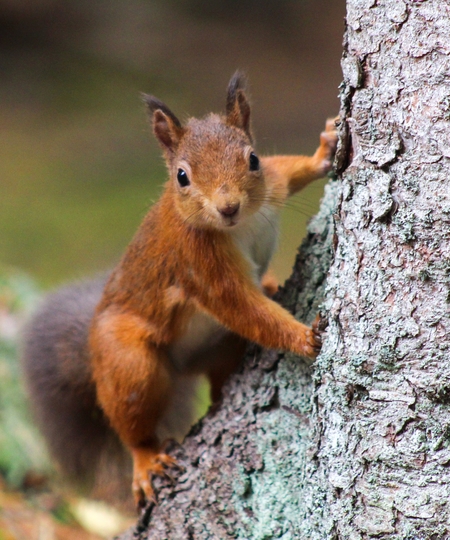
Discover our Pinetum, Walled Gardens, Murray Star Maze and more. Click here to see our pathway map.

Discover the beautiful Kitchen & Walled Gardens, where we source produce and flowers for the Palace.

Enjoy our woodland playground with a rope slide, swings, climbing walls, slides and more.

Visit our rare conifers collected by the 4th Earl of Mansfield in the 19th Century Pinetum.

Our gardens are also steeped in horticultural histroy, from Augustine monks tending the land to John Loudon & David Douglas.

Famous explorer and botanist, David Douglas was a son of Scone, and famed for introducing the Douglas Fir to Scotland.

The Grounds at Scone Palace are home to a variety of wildlife, including the beloved red squirrel, roe deer, the rare hawfinch and more.

Budding horticulturalist or just want a chance to learn? Join our enthusiastic garden volunteers today.

Explore our Maze, designed in the shape of the five-pointed star that features in the Murray family crest.
History of Gardens
900 years ago the Augustine monks first began tending the land around the abbey. Today the abbey is gone and the ground bears witness to the early 19th century vision of the 3rd Earl's landscape designer, John Loudon. But beneath the grass and among the trees, within sight of the palace there are still many reminders of Scone's more distant past.
Everywhere there are trees to marvel at and the trees at Scone forge another strong link with the past. Close by the palace stands a huge old Sycamore, its provenance as impressive as its size. This majestic tree is said to have been planted by James VI and I in 1617, on his only visit to Scotland following the Union of The Crowns in 1603. The magnificent David Douglas Fir, was brought over by David Douglas who was a son of Scone. Fine old Cedars of Lebanon surround the chapel and hint at the antiquity of the place as well as the Victorian pinetum.
Garden Tours
Ideal for Horticultural Groups and Gardening Clubs, we offer private tours around our Grounds and Gardens with our Head Gardener Brian Cunningham. Brian has regularly featured on BBC Beechgrove Garden covering a variety of gardening projects which he and his team have been working on over the past 3 years. These include reinstating the Kitchen Garden and telling the story of David Douglas.

The Walled & Kitchen Garden
In the Walled & Kitchen Garden, herbs are planted for their colour and scent as companions to the vegetables, which are consumed year-round in the Palace coffee shop.
Sweet Peas, Aquilegia and Dianthus are among the cut flowers also grown here for seasonal displays in the palace.
The high brick wall beyond the Kitchen Garden encloses the four-acre Victorian Walled Garden, currently under redevelopment. It was designed by the palace architect, William Atkinson, who built coal-fired heating ducts into the north wall. In cold weather these were tended overnight by the apprentice gardeners living in the cottage nearby.
Today the Scone Palace gardens are partly maintained by a team of 20 volunteer gardeners.

The Pinetum
The Scone Pinetum is of international interest and we work closely with the Royal Botanical Gardens in Edinburgh. A recently created memorial walk around the Pinetum leads past the eleven oak trees planted to commemorate the lives of the eleven estate foresters and gardeners lost in World War I.
The Victorian Pinetum is home to many rare species, including three families of giants, the Hemlocks, the Noble Firs and the Sequoias. To saunter down their avenues is to feel dwarfed by these prodigies of nature.

David Douglas
Among the finest of all the trees at Scone is a giant Douglas Fir. It is prized not just for its size, but because it was raised from the first seed sent home from North America in 1826 by the man after whom it is named: David Douglas. This famous early 19th century explorer and botanist was himself a son of Scone.
David Douglas was born in the village of Scone in 1799 and worked as an under-gardener in the newly-landscaped palace grounds. He later went to work at the Botanical Gardens in Glasgow where his talent was quickly noticed and he was sent to North America as a collector for the Royal Horticultural Society. In the course of only a few years he sent back over 200 new species of plants. Lupins, phlox, sunflowers, Californian poppy, mimulus, flowering currant and snowberry are just a few of the common plants he discovered.

Douglas travelled widely and adventurously, from Oregon to Hudson’s Bay and even Hawaii, recording and collecting plants wherever he went.
His journeys took him through unmapped forest and to the summits of previously unscaled mountains. To celebrate the significance of the plant introductions Douglas made to the world of horticulture today, visit the Douglas Pavilion and follow the Douglas Trail around the gardens which highlights the modern day cultivars derived from some of his original introductions.

Nature Trails
The Grounds at Scone Palace are home to a variety of wildlife. The red squirrel is attracted to the great woodlands, as are roe deer. The estate grounds provide a sanctuary for birdwatchers with the rare Hawfinch which can be spotted in Lime Avenue. Oystercatchers and swallows also make their debuts. On a warm and sunny day look out for an array of butterflies in the colourful Butterfly Garden. Sightings of the rare “comma” butterfly have been recorded. Also, look out for the peacocks who roam freely around the palace grounds!

Volunteer
We have a number of garden volunteers who help out our gardening team in the grounds at Scone Palace. It is a brilliant way to learn about gardening and immerse yourself in nature whilst learning about botany in Scone Palace's rich horticultural history. If you'd like to walk in the same footsteps as David Douglas and join our wonderful team of Volunteers, please email Brain Cunningham, our Head Gardener at gardenvolunteering@scone-palace.co.uk

The Maze
The maze was designed by international maze designer Adrian Fisher. At its centre is a bronze statue designed by David William-Ellis, representing the water nymph, Arethusa.
The maze is planted in a mixture of copper and green beech, designed to resemble the Earl of Mansfield’s family tartan, Ancient Murray of Tullibardine, and is in the shape of a five-pointed star which is part the Family’s emblem.
The maze was planted in 1991 with 2,000 beech trees and over 800 metres of paths. The shortest way to the centre of the maze means a walk of only about 30 metres; we'll let you discover the longest walk for yourself ...
The bridge over the entrance is based on a design from the Glasgow Garden Festival in 1988 and is made of timber from the Scone Estate.










